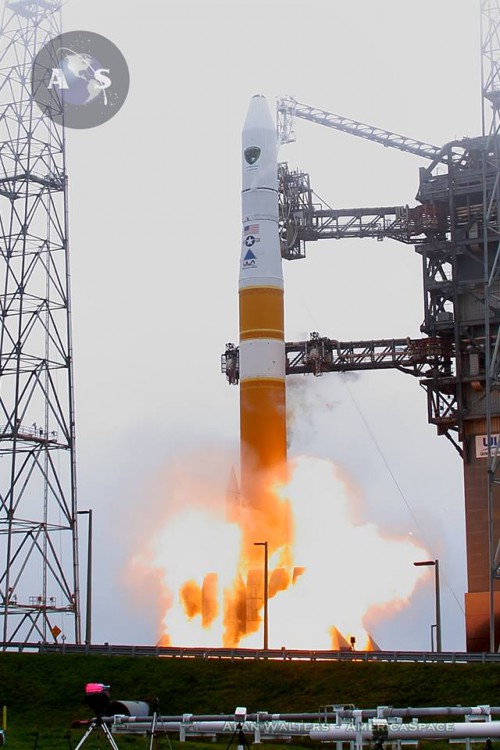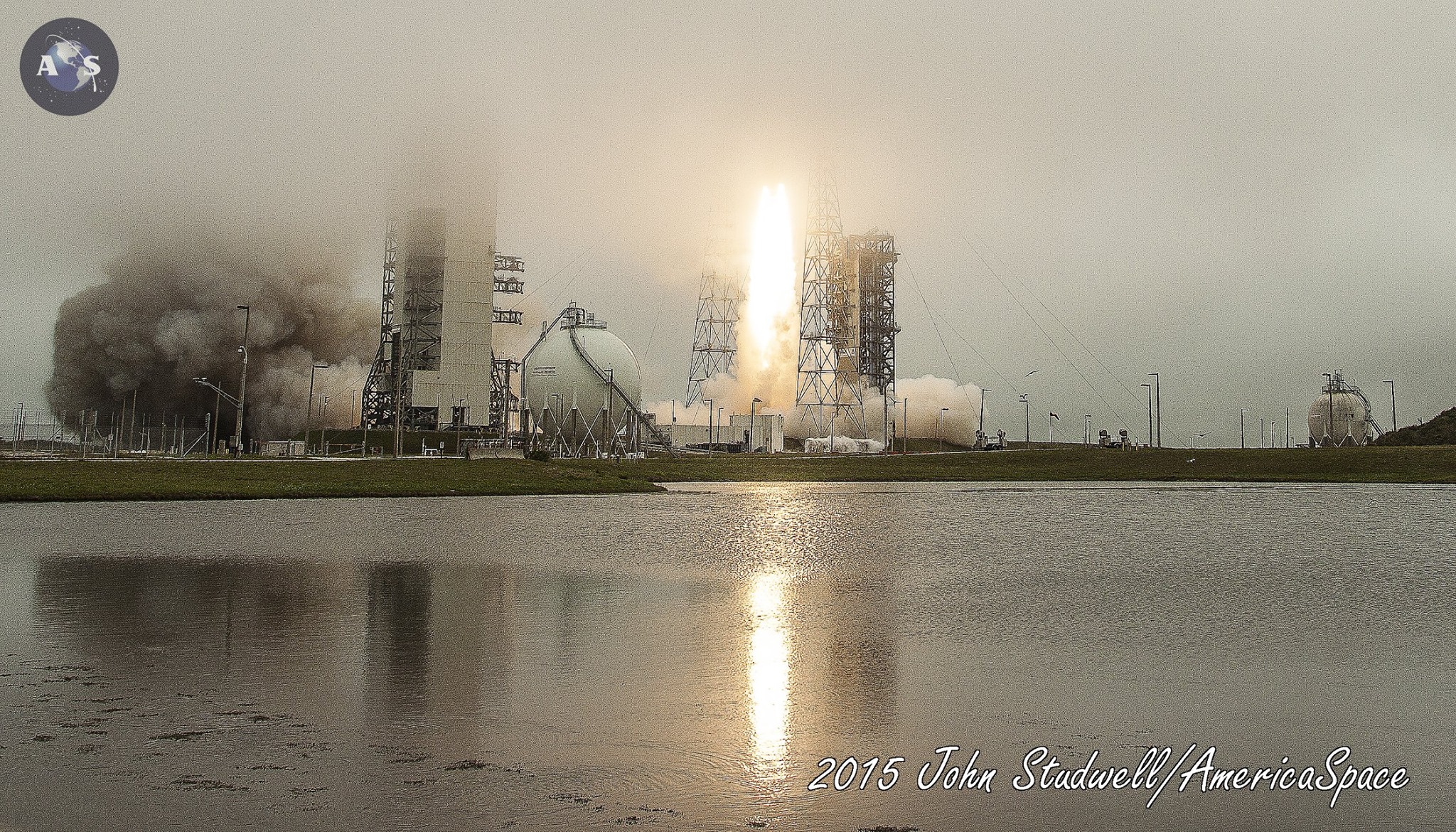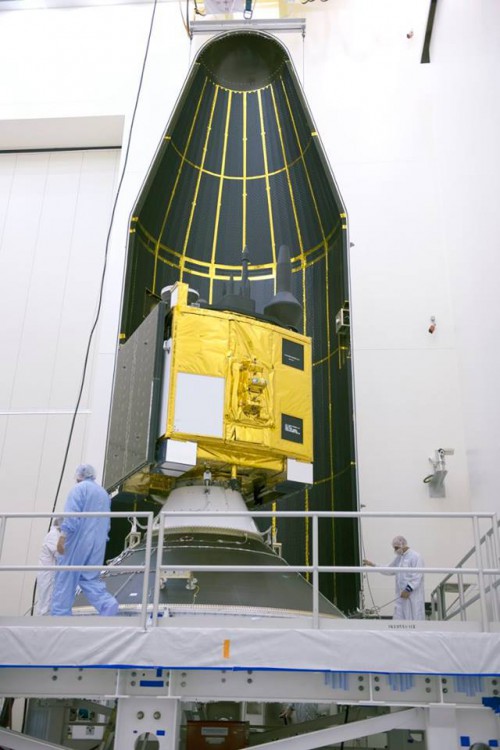|
|
 |
 |
 |
 |
GPS IIF9 heads into orbit on a Delta IV rocket
Article by: Mike Barrett
Date: 26 Mar 2015

Yesterday the ninth block IIF GPS satellite was successfully launched into orbit by United Launch Alliance for the US Air Force. The navigation satellite was enshrouded in a 4 metre payload fairing as it stood on the launch pad on top of a Delta IV rocket.
The countdown to the launch started eight hours prior to ignition with the removal of the service tower. Four hours before launch the two stages of the rocket were filled with cryogenic fuel. After numerous safety checks were made the terminal countdown started four minutes before launch.
Just before launch the rocket was engulfed in a ball of flame as the surplus hydrogen was ignited. The two solid rocket boosters were lit and the rocket and GPS satellite thundered into the misty skies.
Continue to read an extract of the launch report from AmericaSpace.Com...
The following is reproduced with permission from AmericaSpace.Com
United Launch Alliance (ULA)—the Centennial, Colo.-based launch services operator of Atlas V, Delta IV and Delta II boosters, out of Cape Canaveral Air Force Station, Fla., and Vandenberg Air Force Base, Calif.—has successfully delivered the ninth of an eventual series of 12 Global Positioning System (GPS) Block IIF satellites into a Medium Earth Orbit (MEO), at an altitude of 11,047 nautical miles (20,460 km). ULA lofted its storied Delta IV Medium+ (4,2) from the Cape’s Space Launch Complex (SLC)-37B at 2:36 p.m. EDT Wednesday, 25 March, precisely on the opening of an 18-minute “window”. With four missions now achieved in just three months, the company is in pole position to achieve its target of 13 launches by the end of 2015.
The Delta IV Medium+ (4,2) is numerically designated to identify a 13-foot-diameter (4-meter) Payload Attach Fitting (PAF) and the presence of two solid-fueled Graphite Epoxy Motors (GEM)-60. It was utilized for the maiden voyage of the Delta IV, way back in November 2002, which launched the commercial Eutelsat W5 communications satellite into Geostationary Transfer Orbit (GTO). Since the formation of ULA as a merger between Boeing and Lockheed Martin in December 2006, the variant has earned for itself a reputation as one of the company’s most reliable workhorses. As a rocket, it can loft payloads up to 26,280 pounds (11,920 kg) into Low-Earth Orbit (LEO) and up to 14,800 pounds (6,720 kg) into GTO.

Delta-IV launching the GPS IIF-9 satellite to orbit. Photo Credit: Alan Walters / AmericaSpace
Since its maiden voyage, the Medium+ (4,2) boosted the classified NROL-22 and NROL-27 reconnaissance satellites in June 2006 and March 2011, respectively, on behalf of the National Reconnaissance Office, as well as a pair of Geostationary Operational Environmental Satellites (GOES) for meteorological research in June 2009 and March 2010. Between May 2010 and today, it has placed six members of the now-nine-strong GPS Block IIF network into MEO. (The others have been delivered to orbit by ULA’s Atlas V, most recently the GPS IIF-8 satellite, last October.) In spite of an upper-stage thrust shortfall during the GPS IIF-3 ascent in October 2012, the Medium+ (4,2) has never failed to deliver a primary payload into orbit. Wednesday’s flight was the 13th mission by a Medium+ (4,2), as well as the 29th overall by a Delta IV and the 95th overall voyage by a member of ULA’s venerable fleet of boosters.
Preparations for the mission entered high gear at 6:06 a.m. EDT Wednesday, when the Mobile Service Tower (MST) commenced its 25-minute rollback to expose the Delta IV Medium+ (4,2) to the elements. This revealed a vehicle whose central element is a single Common Booster Core (CBC), which stands 134 feet (41 meters) tall and is equipped with a single RS-68 engine, developed by Aerojet Rocketdyne. Fueled with cryogenic oxygen and hydrogen, the RS-68 generates 663,000 pounds (300,000 kg) of propulsive yield at the instant of liftoff. The stack is topped by the Delta Cryogenic Second Stage (DCSS), which is powered by a restartable RL-10B2 engine, capable of 24,750 pounds (11,220 kg) of thrust and utilized for the final delivery of payloads into their operational orbital positions. Meanwhile, each of the twin GEM-60 strap-on boosters provides an additional 191,400 pounds (86,820 kg) of thrust and are the primary drivers for the characteristically rapid pace that the Medium+ (4,2) leaves the pad.
As noted in AmericaSpace’s GPS IIF-9 preview, predictions from the 45th Space Wing at Patrick Air Force Base initially called for an 80-percent likelihood of acceptable weather conditions at T-0, citing Flight Through Precipitation and Cumulus Clouds as the principal violating factors. However, as Wednesday morning progressed, the situation brightened markedly and by 11:00 a.m. forecasts were updated to 90-percent “Go”.
Shortly thereafter, the effort to load liquid oxygen and hydrogen propellants aboard the CBC and the DCSS got underway with the chilling-down of tanks, Ground Support Equipment (GSE), fuel transfer lines and valves. This protocol is necessary to guard against thermal shock as the cryogens pass through various components. By 11:20 a.m., fueling of the CBC was underway and efforts to load propellants aboard the DCSS began about 20 minutes later. Both hardware elements then entered “Topping Mode”, whereby the rate of fueling slowed in order complete the filling of the tanks and replenish any cryogens which boiled off in the final hours of the countdown. Shortly after midday, both liquid oxygen and hydrogen had attained Topping Mode in the CBC, and by 12:35 p.m. all propellants had been successfully loaded aboard the DCSS.

Into the fog, Delta-IV GPS IIF-9. Photo Credit: John Studwell / AmericaSpace
By 1:10 p.m., with less than 90 minutes remaining before the opening of today’s launch window, all stations were declaring themselves “Green” (“Go for Launch”), with regular weather balloon deployments to ascertain the changeable wind conditions at higher altitudes. In spite of a dense, low-lying fog, the weather remained stable at 90-percent favorable. With the countdown clock scheduled to emerge from its final build-in hold at T-4 minutes, it was imperative that all remained satisfactory. Although the hold time is of variable length, and is employed to establish a precise T-0 within the window, the fact that only 18 minutes existed—from 2:36 p.m. through 2:54 p.m.—left little time to resolve any hardware issues if they had arisen in the late stages of the countdown. Fortunately, the Delta IV Medium+ (4,2), the payload and the Eastern Range remained ready to support an on-time launch.
At length, the Launch Director polled the ULA and contractor team and received a unanimous “Go for Launch”, allowing the clock to be released and the countdown resumed at T-4 minutes at 2:32 p.m. In the final minutes, flight plans were uploaded to the rocket’s on-board navigation computer, the propellant tanks were secured and the fill-and-drain valves were closed for flight. The mighty Delta was transferred to internal power and at T-3 minutes the Flight Termination System (FTS)—tasked with destroying the Delta IV in the event of an accident during ascent—was placed onto internal power and armed. With all liquid oxygen and hydrogen propellants confirmed at flight pressures, the Eastern Range declared its readiness to support the launch at T-60 seconds. “Eastern Range readiness has been verified,” noted AmericaSpace’s Launch Tracker at 2:35 p.m. “The tracking stations are all online and the ground stations are receiving telemetry from the rocket. The Launch Hazard Area has been cleared of shipping.”

The GPS IIF-9 being encapsulated in preparation for its scheduled March 25 launch. This is the first of three GPS IIF satellites scheduled for launch in 2015. Photo Credit: USAF
Heralded by a shower of sparkler-like igniters to burn off excess hydrogen, the RS-68 engine of the CBC roared to life at T-5 seconds and underwent a brief period of computer-controlled health checks, ahead of the command to fire the twin GEM-60 strap-on boosters at T-0.01 seconds. Hold-down clamps were released and climb-out from SLC-37B got underway at T-0. Powered uphill with noticeable rapidity, thanks to the harsh impulse of the solids, the Delta IV Medium+ (4,2)—which stands 206 feet (62 meters) tall, when topped off with its Delta Cryogenic Second Stage (DCSS) and Payload Attach Fitting (PAF)—literally kicked off its first mission of 2015.
Eight seconds into the flight, the booster executed a combined pitch, yaw and roll program maneuver to establish itself onto the proper 46.16-degree flight azimuth to inject the GPS IIF-9 payload into MEO. It burst through the sound barrier at T+48.4 seconds, and, at one minute after launch, encountered a period of maximum aerodynamic turbulence on its airframe, known colloquially as “Max Q”. The GEM-60 boosters, each of which measures 53 feet (16.1 meters) in length, exhausted their solid fuel at T+95 seconds and were jettisoned at 100 seconds into the mission. This left the RS-68 to propel the stack towards orbit for a further three minutes. It was shut down at T+248.1 seconds and discarded seven seconds later, ahead of the ignition of the DCSS.
The restartable RL-10B2 engine of second stage came to life for the first of two “burns” at T+269.6 seconds. Eleven seconds later, the two-piece (or “bisector”) shell of the PAF was jettisoned. Measuring 38.5 feet (11.7 meters) long, the bullet-like PAF provided GPS IIF-9 with aerodynamic, acoustic and thermal protection during its ascent through the low atmosphere. Its departure exposed the satellite to the space environment for the first time. The RL-10B2 shut down at T+930.9 seconds—some 15 minutes and 30.9 seconds after launch from the Cape—and the stack entered a “coasting” phase of almost three hours.
Click here for the full report at www.americaspace.com.
| Comments
|
| Be the first to comment. Click on Post Reply below. |
|
|
 |
|
|
 |
 |
 |
 |
|
|